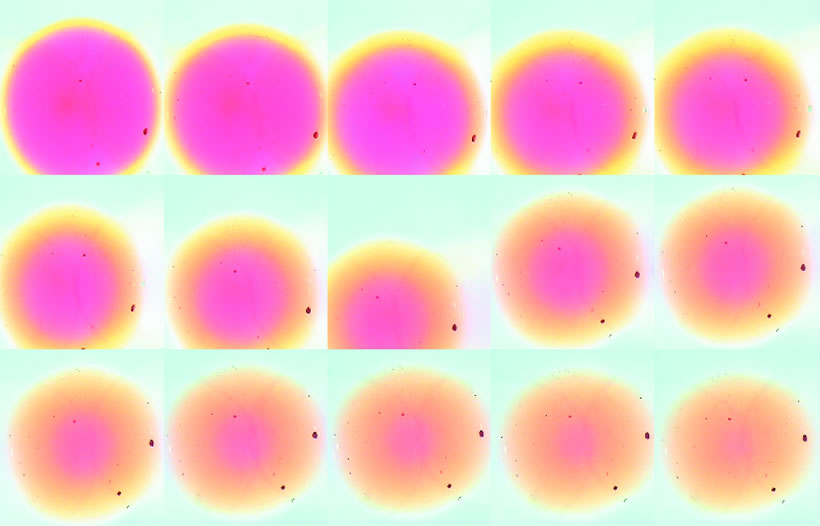
| 1961-1982 | 1983-1986 | 1987-1993 | 1994-1997 | 1998-2002 | 2003-2005 | 2006-2008 | 2009-2011 | 2009-2011 |
an emphasis on investigation
|
2003. Science department in elBullitaller.
Our interest in establishing a dialogue with science began to become consolidated in 2003
when we contacted Pere Castells, a scientist and gourmet. At first, the relationship was informal, but as the Alícia Foundation project
took shape, it gradually took on a more professional nature, right up to the implementation of the science department, which represented
a bridge between the Workshop and Alícia. With Pere Castells and Íngrid Farré, who joined soon afterwards, we began by organising ourselves,
looking for a work structure, establishing contacts with manufacturers of food products, new devices or instruments, gathering information
and reading books, and so on. From 2004 onwards, Pere and Íngrid carried on this research in Alícia. We also analysed the world of
textures that we had created in recent years (foams, hot jellies, clouds, airs, texlavazza, spherification, etc.), and we decided to
find out why these preparations were possible, what physical and chemical processes were involved and how the products that made these
textures possible acted. All this was because of our conviction that awareness of the scientific processes involved in cooking constituted
the basis for evolution.
about molecular cuisine, by Ferran Adrià |
Photos of the process of caviar spherification, obtained using an electronic microscope. |
| printable version | X | ||
| about molecular cuisine | ||
| by Ferran Adrià |
|
Judging by the questions I’m asked, everybody seems to think that I am the pioneer, creator or leading
light of molecular cuisine.
I’m not exaggerating: nine out of ten interviews bring this topic up, when I have never said anything related to molecular cuisine and elBulli. To start with, I think scientific work deserves respect, and should not be trivialised in this way. Just to set the record straight: up until 2003, after at least fifteen years of innovation, including the setting up in 1997 of our workshop, the first systematic research centre for a three-star restaurant, our contact with the scientific world had been sporadic. We only got to know Harold McGee or Hervé This through conferences, particularly from 2000 onwards, although This did take part in an Escoffier Foundation event in 1996, in Biarritz, where I gave a demonstration. This is why we have never ascribed any scientific origin to our creations, which have come about from a purely culinary quest: observation and curiosity have been part and parcel of our activity, in my case for almost a quarter of a century. For example, in 1998 when we discovered that agar-agar could withstand high temperatures, we created hot jellies based on nothing other than observation. 
It wasn’t until 2003 that our collaboration with the scientist and gourmet, Pere Castells, began, resulting in the setting up of the Alícia Foundation. With Pere we managed to do what would have been impossible with any other scientist: to exchange ideas and build up a work structure. One specific result of this partnership was the publication of a Scientific and Gastronomic Lexicon, a tool designed to bridge the gap between these two worlds. But coming back to my alleged role as a pioneer of molecular cuisine, here I must be blunt: I think that what we have here is a marketing operation and the public should not be tricked into believing that molecular cuisine is a cooking style. To cook well, we must learn (its history, techniques, products, tradition and innovation, culinary processes, etc.), and then think, discuss, try out, reflect, choose... And then constantly question anything we assume is true. And if in the mean time we need to resort to science or history books or any other creative discipline, at least we shall acquire new information to reinforce our culinary philosophy. This confusion is one of the reasons we drew up a Synthesis of our cuisine: 23 points to define what we do. One of the things it brought home to us is that the role of research or science, while important, was limited to just one of the 23 points. Cooking is much more than that, or rather, it is something different; at any event, out of respect for the scientific world, a respect that should begin by not having its work trivialised, I shall never mix the two. Naturally, if a chef wants to label his work as molecular cuisine, he is perfectly at liberty to do so. But in the name of that liberty, I claim to be merely a cook; and everything we do at elBulli as cooking. * Molecular cuisine was originally called molecular gastronomy. In the 1980s, a few scientists interested in gastronomy (including Nicholas Kurti, Harold McGee and Hervé This) began to study the physical and chemical processes that occurred in a kitchen. This movement was dubbed molecular gastronomy. In fact, this was a practice that had been common in the food industry for some years, although in that case the objective was simply cooking. Strangely enough, while molecular gastronomy gave its inventors a name, contacts with chefs could be counted on the fingers of one hand. Furthermore, molecular gastronomy ignored certain aspects that today mark the difference from the cooking of ten years ago – for example, the new hydrocolloids: thickeners, gelling agents, emulsifiers and so on. To claim that anyone using these products is practising molecular cuisine only serves to confuse the public, as does the suggestion that the first person to make a foam or a savoury ice cream was guided by scientific principle (and God only knows how ignorant we were of the world of science when we had the idea of using the whipped cream siphon in 1994). |


|

